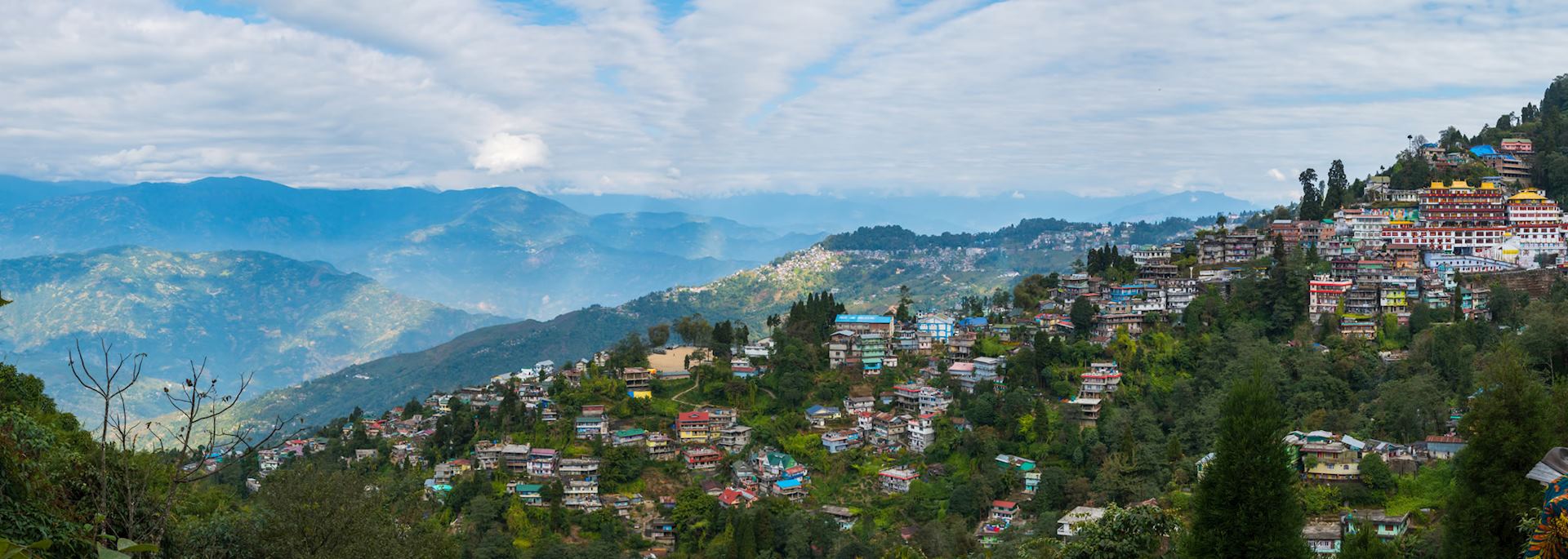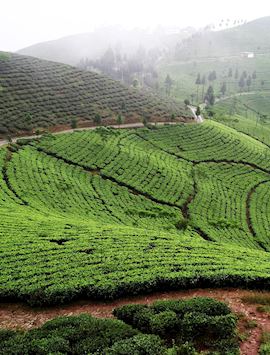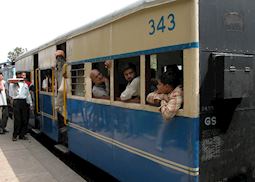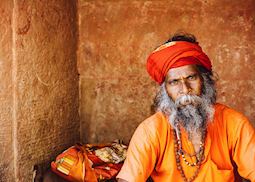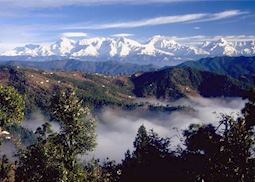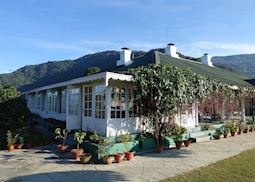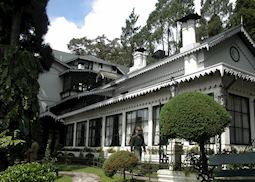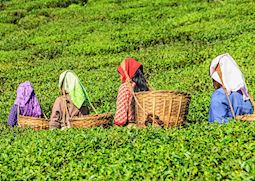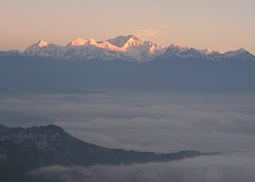Jump to:
Driving along the ribbons of road that lead to Darjeeling, past gravity-defying hillside settlements and tea plantations, you can feel quite the adventurer. The spiny ridges of the Himalaya poke out above, with the sharp peak of Kangchenjunga dominating the skyline.
It can also be somewhat of a surprise, when you arrive in the hill station, that it feels rather international. The British Raj left behind mock-Tudor homes and Gothic churches, which sit alongside Buddhist temples and shrines from the time when the region was part of Nepal. The markets are bright with textiles, woven by the hundreds of Tibetans who live here in exile and sell wares alongside Bhutanese merchants. Pause to take stock, and you’re likely to be offered a cup of spiced chai by one of the Bengali tea-stall vendors.
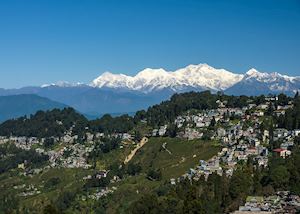 The best way to explore is by walking — albeit slowly, Darjeeling is 2,134 m (7,000 ft) above sea level. You can start by walking up Observatory Hill. From the summit, on a clear day, you’re able to see the forest, rock and snow of the mountains layered across the skyline.
The best way to explore is by walking — albeit slowly, Darjeeling is 2,134 m (7,000 ft) above sea level. You can start by walking up Observatory Hill. From the summit, on a clear day, you’re able to see the forest, rock and snow of the mountains layered across the skyline.
The hill was once the location for Darjeeling’s first Buddhist monastery and a sacred cave for Hindus. You’ll now find Mahakal Temple, a bright collaboration of Hindu deities and flickering strings of Buddhist prayer flags.
From the temple, you can walk down Chowrasta Mall (The Mall to locals), which is lined with wooden-fronted bookshops, tea emporiums and cafés. Bhotia Market runs off into a side street and is where you can pick up hand-knitted Tibetan socks, hats and gloves.
If you’re keen to shop, we also recommend visiting the Tibetan Refugee Self Help Centre. You can watch craftspeople wool spinning and carpet weaving, with the money from any purchases you make going directly to a rehabilitation initiative for displaced Tibetans.
To the north of the town is the Himalayan Mountaineering Institute, founded by Tenzing Norgay. It houses a small museum dedicated to mountain climbing, as well as a display of photographs and memorabilia from Norgay’s summit of Everest with Edmund Hillary in 1953. The museum includes a model of the entire Everest massif, which shows how close in height Everest, K2 and Kangchenjunga are when you look at it from above.
For views of the real Everest range, you can take an early morning trip up Tiger Hill, a small plateau about an hour’s drive from Darjeeling. Below the plateau, the valleys widen into a natural amphitheatre, with the Everest range spread out almost as perfectly as the Mountaineering Institute’s model.
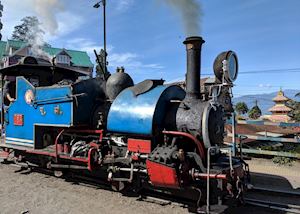 As the sun rises, it initially picks out the serrated peak of Kangchenjunga (which, from your angle, appears taller than Everest), before basking the rest of the range in a pink glow. The best time (but also the busiest) for this trip is in October or November when the skies tend to be clear. There is a very commercial viewing lounge where you can watch in warmth, but we suggest wrapping up warm and watching in the cool morning air.
As the sun rises, it initially picks out the serrated peak of Kangchenjunga (which, from your angle, appears taller than Everest), before basking the rest of the range in a pink glow. The best time (but also the busiest) for this trip is in October or November when the skies tend to be clear. There is a very commercial viewing lounge where you can watch in warmth, but we suggest wrapping up warm and watching in the cool morning air.
Arguably, Darjeeling’s most popular attraction is the Darjeeling Mountain Railway, one of India’s last remaining toy train routes. The best way to experience this engineering masterpiece is to ride to Ghoom, forty minutes away, on the (usually) daily steam locomotive. The train pauses at the Bastia Loop along the way, where you can disembark to admire the smoking engine and views back toward Darjeeling.
Darjeeling’s tea plantations
Darjeeling tea is often described as the champagne of teas, due to its light shade and floral aroma. Ever since an Englishman (records disagree on who) brought across seeds from China in the mid-19th century, tea has been the region’s main crop. You’ll see the neat rows of squat tea bushes as you drive around, with many plantations now open to visitors.
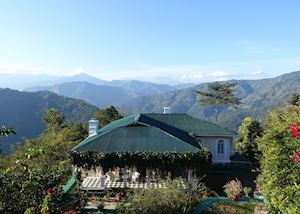 Originally a Scottish tea company, Glenburn Tea Estate is now owned by an Indian tea planting family, who have lovingly restored the colonial planters’ bungalows as guest suites. During your stay, you can hike through the tea fields, learn about the tea process at the nearby factory and sample a variety of brews, as well as relax in the hotel’s mini spa and gardens. The retreat can prove a good option after a few nights in Darjeeling town.
Originally a Scottish tea company, Glenburn Tea Estate is now owned by an Indian tea planting family, who have lovingly restored the colonial planters’ bungalows as guest suites. During your stay, you can hike through the tea fields, learn about the tea process at the nearby factory and sample a variety of brews, as well as relax in the hotel’s mini spa and gardens. The retreat can prove a good option after a few nights in Darjeeling town.
Best time to visit Darjeeling
There are two main seasonal windows for visiting Darjeeling. Arguably the best is October to November, when the temperatures are comfortably cool and, all importantly, the skies are usually clear enough to see the Himalaya. The second runs from late February to May, when the cold winter has passed and temperatures begin to warm again. June tends to welcome the monsoon, which lasts until early September, so we don’t recommend travel to Darjeeling at this time.
who's been there
-
01993 838 92501993 838 345
- Make an enquiry
Suggested itinerary featuring Darjeeling
This sample itinerary will give you an idea of what is possible when you travel in Darjeeling, and showcases routes we know work particularly well. Treat this as inspiration, because your trip will be created uniquely by one of our specialists.
Places near Darjeeling
- Kalimpong 14 miles away
- Rinchenpong 16 miles away
- Gangtok 30 miles away
- Manas National Park 172 miles away
- Guwahati 224 miles away
- Assam 272 miles away
Photos of Darjeeling
Our expert guides to exploring Darjeeling
Written by our specialists from their own experiences of visiting Darjeeling, these guides will help you make the most of your time there. We share both our practical recommendations and the best ways to appreciate Darjeeling at its best.
-
India’s toy trains: Shimla, Darjeeling and Ooty ![Steam train up to Shimla]()
India’s toy trains: Shimla, Darjeeling and Ooty
India’s toy trains: Shimla, Darjeeling and Ooty
The toy trains of India cross valleys, ravines and rivers to access some of the country’s most scenic landscapes. India specialists share their experiences of riding on mountain railways from the Himalayan hill stations of Darjeeling and Shimla to the tropics of Ooty.
Read this guide -
What to do in India: our highlights guide ![Sadhu in Varanasi]()
What to do in India: our highlights guide
What to do in India: our highlights guide
Our India specialists pick some of their best things to see and do, and where to stay from the Himalaya to Kerala. Include spotting tiger, staying in a palace in Rajasthan, taking a boat trip down the Ganges and experience one of the country’s many festivals in your trip to India.
Read this guide -
Walking in India: on foot through the Himalaya & the Western Ghats ![View from Leti, Almora]()
Walking in India: on foot through the Himalaya & the Western Ghats
Walking in India: on foot through the Himalaya & the Western Ghats
Exploring India on foot, you pass through remote villages, stop for tea with local people and stumble upon hidden temples. Our India specialists suggest routes through the hills of the Western Ghats, tea plantations of Darjeeling and foothills of the western Himalaya.
Read this guide
Accommodation choices for Darjeeling
We've selected a range of accommodation options for when you visit Darjeeling. Our choices usually come recommended for their character, facilities and service or location. Our specialists always aim to suggest properties that match your preferences.
-
![Glenburn Tea Estate]() Responsible ChoiceWe've hand-selected a range of tours and stays across the world that go above and beyond to be a force for good by supporting local businesses, educating staff, challenging local norms, or promoting conservation and biodiversity efforts. Your Responsible Choice helps increase the positive impact of your trip.
Responsible ChoiceWe've hand-selected a range of tours and stays across the world that go above and beyond to be a force for good by supporting local businesses, educating staff, challenging local norms, or promoting conservation and biodiversity efforts. Your Responsible Choice helps increase the positive impact of your trip.Glenburn Tea Estate
Darjeeling -
![New Elgin Hotel, Darjeeling]()
New Elgin Hotel
Darjeeling
Ideas for experiencing Darjeeling
Our specialists seek out authentic ways to get to know the places that could feature in your trip. These activities reflect some of the experiences they've most enjoyed while visiting Darjeeling, and which use the best local guides.
-
Tea Plantation Visit ![Darjeeling tea plantations]()
Tea Plantation Visit
Tea Plantation Visit
The stunning scenery of the Himalayan foothills can be experienced by walking through some of the many tea plantations, where you can often see the tea-pickers hard at work delicately removing "two leaves and a bud" to create the best quality tea.
View details -
Tiger Hill Scenic Walk ![Sunrise on Mount Kangchenjunga]()
Tiger Hill Scenic Walk
Tiger Hill Scenic Walk
An early start is recommended for the visit to Tiger Hill, situated around 11 km from Darjeeling. This scenic walk takes around two hours.
View details

